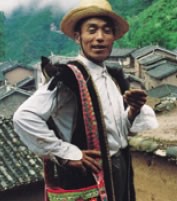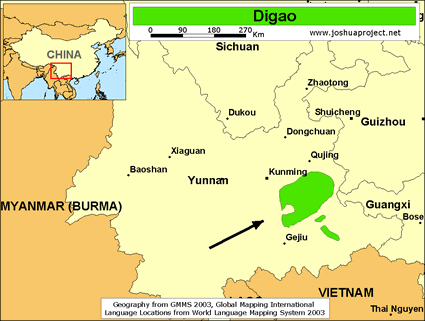The many Yi groups in China, including the Digao, once lived farther to the north of their present location. When Marco Polo passed through the Yi regions in the thirteenth century, he recorded, "Caindu is a province lying towards the west, and there is only one king in it. The people are idolaters, subject to the Great Kaan, and they have plenty of towns and villages. ... There is a great lake here, in which are found pearls [which are white but not round]. But the Great Kaan will not allow them to be fished, for if people were to take as many as they could find there, the supply would be so vast that pearls would lose their value and come to be worth nothing." Over the course of many centuries the Yi splintered into numerous ethnolinguistic entities and migrated across a huge area of southern China.
The official classification of the Digao people is somewhat complicated. The Digao are one of five groups in Kaiyuan County that are given the cover name of Aza. The 1996 Chinese publication Kaiyuan Xian Zhi (The Annals of Kaiyuan County) states, "Based on linguistic and cultural differences, the 'Aza' can be divided into five groups." None of these five groups (which also include the Daizhan, Asahei, Labapo and Ani) calls itself Aza. All of these ethnicities have been officially included in the Yi nationality.
The typical Digao house is made of wood, bamboo, and mud. Although today the Digao are rapidly being assimilated by the Han Chinese, in the past each village had an entrance with carved images of birds, the sun, or the moon, under which was a wooden guardian eagle which had been blessed by the bimo (shaman). Opposite the entrance were goats' horns and chicken feathers remaining from sacrifices. In the northeast corner of the house stood a hearth of three stones, which could never be touched by the feet, because they believed it brought bad luck.
Today only the elderly Digao continue to observe the animistic belief in the spirits that marked the identity of their forefathers. Ancestor worship is still strong, however. Annual ceremonies are held to honor the spirits of the Digao's parents.
There are no known Christians among the Digao. The Catholics had a small work in Kaiyuan prior to 1949, with one priest, Father Booker, living in the county between 1910 and 1933. He was buried at Lukude. This work resulted in about 2,000 believers among the Hmong, but the various Yi groups were not reached.
Without the guidance of Christ, these people will be lost in this life and the life to come. They need someone to go to them as Christ-bearers.
Pray for the Lord to intervene in their families, calling people to his side.
Pray for loving workers.
Pray for their hearts to be drawn to the Lord of lords.
Pray for a church planting movement to thrive in their communities.
Scripture Prayers for the Digao in China.
Operation China, Asia Harvest, Copyrighted © Used with permission
| Profile Source: Joshua Project |











